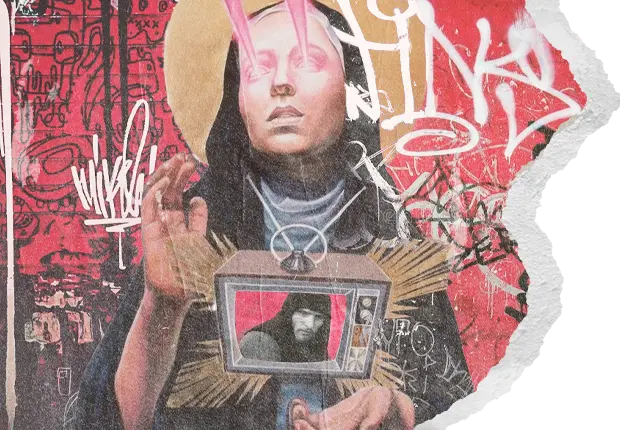Rublev
Let’s start out with a self-evident presupposition: Western critics are stupid.
They were stupid in the 1960s, as they cheered a great cultural transformation that promised liberation but brought us the complete opposite. They were just as stupid evaluating the inevitable outcome of that transformation—grasping at spiritual depth and aestheticism in works where any outside observer could clearly see none remained.
Most of all, Western critics are stupid when they elevate themselves and their own parochial concerns, their own introversion, to the level of the highest artistic ideals. Western critics, mired in Cold War moralising, understood every piece of art from behind the Iron Curtain as either stunted regime-art or a cri de coeur, a desperate call to be free—to be just like the critics. They’re still doing this today, in the service of democracy and “universal” rights.
So when Western critics universally proclaim the Russian film Andrei Rublev (1966) to be a masterpiece, an inevitable question we must ask ourselves is: Are they being stupid again? Chances are, the answer is going to be “Yes.”
In fact, it’s “Yes” and “No.” The critics are still being stupid, but they’re right even though they’re wrong. Andrei Rublev is indeed a masterpiece.
On its face, the film is a “biopic” of the eponymous Russian icon painter who lived and died in the 15th Century. Yet it is a notoriously esoteric film—woven together by eight partially-related vignettes (not including a prologue and epilogue)—directed by the great Russian filmmaker, another Andrei, Tarkovsky. It speaks to the most epic themes of the Western canon — faith, art, war and peace — yet it is hard to find a concrete thing to say about it all. Crafted under the oppressive weight of the Soviet regime at the height of the Cold War, the film defies any straightforward interpretation. So critics, faced with the inscrutable (at least from a modern, Western vantage point) have spent the past five decades interpreting it through the prism of their own self-regard.
We meet Andrei in the year 1400 along with companions Daniil and Kirill, three traveling artist-monks seeking work when they stop in a tavern and report a jester to the authorities for his blasphemy. Their faith in worldly institutions starts out strong. Due to his superior skill, Andrei is chosen by famed icon painter Theophanes to serve as his apprentice, sending the three men on separate paths and launching Andrei’s career. We experience the horrors of the world as Andrei sees it: brutal rulers, Mongol hordes, pagan rituals, and the corruption and cruelty of his beloved Russian people. He becomes gradually disillusioned with his role as an artist until, forced to take a life to save another, he takes a vow of silence and forsakes his calling. What point is there to engage with the world when only death brings an end to the suffering, for which all are complicit? In the final hour, we see an inexperienced young boy cast a church bell with the skill of a master craftsman. Andrei is once again inspired to paint.
“Biopic” is put in quotations, however, because Tarkovsky crafts his artist from nearly whole cloth. Andrei Rublev was certainly a real person. He was born in 1360 and died sometime in the 1420s at Moscow’s Andronikov Monastery. He trained under Theophanes and was a prolific painter of frescoes and religious icons, best known for his depiction of The Trinity. At the time, this meant painting as a patron of princes or the Church. The artist lived not only to serve God, but his earthly masters as well.
Rublev surely suffered under the centuries-long Mongol yoke that still weighed heavily on Russian shoulders. Russian princes and feudal lords actually held a large degree of autonomy as long as they paid tribute to the suzerain, so the people suffered from their petty rivalries most of all. As the Christianization of Russia was still an ongoing process, Rublev was likely aware of pagan heresies as well. But little else is known about his life.
What the film shows, however, is that the artist need not depict the suffering of the world around him, but a world that aspires—or can aspire, with the help of the artist—to be better than it is. His legacy lives on as the pinnacle of Russian art, the combination of two distinct aesthetics. He incorporated the Byzantine style, in vogue during his time, with its flatness, rich colors, and Christian symbolism, but rejected its often gruesome attempts to evoke fear of final judgment. Instead, he embraced the naturalistic serenity expressed in the traditional iconography of Russian pagans. As medieval Russian historian Sergei Zenkovsky put it: “For the Russian people these icons became the finest achievement of religious art and the highest expression of Russian spirituality.”
So we begin to get a picture of why Tarkovsky, a deeply religious man reckoning with his own struggle to produce meaningful art under repressive conditions, was drawn to making the film. Tarkovsky intended the film to be a commemoration of the 600th anniversary of Rublev’s birth. Yet making a film that glorified the Orthodox Church and the Russian nation was about as difficult as one would expect; the film proceeded in fits and starts and sat for years before finally being released in condensed form. Art, and particularly film as the medium grew, was not permitted to be a reflection of the artist, but a glorification of the state and communist ideology—the “princes” and “Church” of Tarkovsky’s day. While it has been narrowly interpreted as an autobiography of sorts, a dissident artist reckoning with his own struggle to create, it is in fact much more. It is a story of how greatness transcends all: ideology, religion, the state, the artist, and even history itself.
The prologue features unnamed characters who never reappear on screen, but nevertheless sets the stage. We see a man preparing to launch a hot air balloon from a tower as a mob of peasants race to stop his blasphemy. The people are “benighted,” backwards, superstitious—but the faceless pilot is a visionary. He launches, and for a few glorious seconds we see the world through his eyes before he crashes to his death. Western critics fatuously interpreted this as the artist’s view of the world, or as Tarkovsky’s own desire to escape the Soviet Union. But they flatter themselves. Tarkovsky is not so inept as to craft a scene that would be so easily censored by Soviet authorities. In truth, the prologue is an exhortation of the man who will defy both the people, the will of God as conventionally understood, and earthly limits — even to his own doom. While this is the most anodyne explanation, it is also, paradoxically, the most subversive.
What Tarkovsky indirectly does is introduce an entirely new—or old—historiography of Russia. Class struggle informed the Soviet understanding of the Mongol yoke, part of the long, inevitable historical process that legitimized Soviet rule. Through a cohesive national identity and class solidarity, “the people” endured a foreign invader and their feudal collaborators. Soviet authorities wanted Rublev to reflect the proletariat ideal, defying the power of church and state to aid the dialectal progress of history. But while Rublev is tortured by these figures, he is no materialist. His oppression—and the peoples’—is portrayed spiritually. How does one find the will to go on amidst such suffering?
On its face, Tarkovsky’s parable conforms to the ideological telling. The two princes in the film are cruel and exploitative. We see from Andrei’s perspective as they compete to surpass each other in grandeur. One of the princes gouges the eyes of his stonemasons so they cannot build his rival a more stately home. And when one prince is away, the other raids his land—raping, pillaging, and murdering the peasants for sport—with the help of the Mongols. The Church enlists Rublev to paint a fearful depiction of the Last Judgment to terrify the people into subjugation. These are undeniably the bad guys, but not for the reason that the Soviets imagine.
“Tell me frankly,” Theophanes asks his apprentice, “Are the Russian people benighted or not?”
“They are,” Rublev responds, “but the question is who is to blame?”
“They are benighted because of their stupidity,” Theophanes asserts confidently—“I serve God, not men.” He thinks Rublev is sinful for believing they can be redeemed.
But Rublev disagrees: “How can you paint being in this frame of mind?”
For Rublev, serving God and serving men is not mutually exclusive.
“People should be reminded that they are human beings; that the Russian people are of one blood and one land. Evil is everywhere, and there are always those who would sell you for 30 coins. New trials are piling on the Russian man — Mongols, famine, pestilence — but they keep on working, working, working, and humbly bearing their cross.”
Later, we see a furious bishop ride up to see why Andrei has not yet completed the church fresco of The Last Judgment. Outside, Rublev and Daniil ponder their lack of progress.
“We could have painted the sinners boiling in tar, so that it would make one’s flesh creep,” Daniil says. “I’ve contrived a demon, smoke pouring from his nostrils.”
“I can’t,” Rublev responds in a fit of passion, bordering rage. “I can’t paint this. I stand against it, do you understand? I do not want to frighten people away.” He cannot complete the painting; he wants people to aspire for good rather than be tricked into acting a certain way.
Combined, these scenes reveal Tarkovsky’s view of the artist as a divine intermediary for the noble Russian people. His role is to lighten their load. The “benighted” proletariat of the Soviet imagination is a victim of false consciousness, absorbing the values of the ruling class through wholly impersonal forces and calling it justice. Tarkovsky agrees they are prone to evil and ignorance, but that is just humanity’s fallen nature. For the Soviets, suffering will continue as long as hierarchy and material inequality remains, but for Tarkovsky, suffering is a permanent feature of the human condition that can be made better or worse by the quality—and the choices—of those who serve as examples. It is a temporal cycle, not a permanent process.
Under this assumption, there is no clear or natural distinction between oppressor and oppressed. The people are just as cruel to one another as their leaders are to them. The common soldier rapes and pillages as he raids his fellow countrymen. “Why, brother, we are Russian too,” cries Rublev’s assistant in vain, before a Russian soldier chases him to his death. “Brotherly love,” as Rublev puts it, is no constant in Russia’s history, but precisely the opposite. Russia’s story is one of both rulers and the ruled—humanity—falling victim to their sinful nature.
This tale is deeply subversive to Soviet historiography because the same critique of Church and state could, of course, be applied to the Politburo. The “benighted” condition of the people is not a function of the historical process gradually resolving contradictions. Rather, the suffering of the people is always a function of the fallibility of leaders within flawed institutions. Without something greater to aspire to, the people will succumb to their base nature.
If greatness begets greatness, the question then becomes, who is qualified to inspire it? This question is what makes Rublev’s parable timely for us today.
Greatness seems not to lie with the earthly leaders of Rublev’s time. The princes are vain and cruel. Even the monastery is filled with petty jealousy. Both are stunted by myopic self-interest. But some, like the man in the balloon, are able to transcend the limitations of man’s nature and speak with a divine hand. It is the artist who is best situated to do this—to depict the truth as he sees it.
But not just any artist. Kirill is stricken with jealousy. He leaves the monastery, furious that Rublev possesses the skill he does not. He is too concerned with greatness to truly achieve it. On the other hand, Daniil is too complacent. He defers to the Church’s authority when Rublev presses him on painting the Last Judgment. He doesn’t aspire to any higher truth. Only Andrei is imbued with the natural vision—spiritual and aesthetic—to transcend the limitations of his time and circumstance. Yet the arc of the film builds towards this internal realization. We never actually see Andrei paint. Rather, we see him recognize this spirit in another.
The hour long final vignette, “The Bell” is among the most moving sequences in the history of cinema. The prince’s men enter a village seeking the master bellmaker to cast a bell for the city, but the entire village is dead from the plague. The only one left alive is the master’s young son, Boriska, who swears his father taught him the secret before he died. The men take him with them to lead the project. Certainly, everyone around him is skeptical. The craftsmen he enlists question his methods—where to dig, the type of clay, the heat of the flames. The boyars attempt to impose their preferences on the design, while the Church authorities question the appropriateness of the religious symbolism. All around him are pressures to conform, but he stays true to his vision. He brings more and more people into the project, knowing they will all be killed if the bell fails to ring.
All the while, we do not know if he is lying. Does he truly know the secret to bellmaking or did he merely say it to escape his desperate circumstances?
The bell rings, and at first we think this means he knew the secret all along. The townspeople revel at the sound of the bell, but Boriska collapses to the ground in tears. A wizened Rublev comes over to comfort him, now a decade into his vow of silence.
“That old brute never told me the secret,” Boriska sobs. “He took it to his grave.”
“You’ve done a fine job,” Rublev responds, breaking his vow to God. “Let’s work together. You’ll cast bells. I’ll paint icons. We will go to the Trinity.”
At first, Rublev’s decision seems paradoxical—why does Tarkovsky want us to feel as though this is a noble climax? Why would Rublev return to make art for the very institutions who he believes corrupt his beloved Russian people? How can he justify breaking his vow to God to never speak or paint again? Does this not all make him a hypocrite and sinner?
Well, it would—if it were anyone but Andrei Rublev. Such vanity would be sinful for the average artist, as Theophanes warned so long ago, but the boy reminds him that he is no average artist. Rublev sees the greatness of the boy, who with no training accomplished a magnificent feat against all odds and every authority assuring him he would fail. He sees the impact the bell has on the common man—how it unites them in purpose, how its joyous ring gives them a work of beauty amidst all their misery. This leads him to reluctantly embrace his own exceptionalism. His art can provide the same relief. Like the boy, he is superior to most men. It would be a far greater sin for them to cower under convention and authority when they know better than those who would waste their mighty talents. Their excellence is God’s will, a divine intervention for the suffering Russian people.
Of course, this can be conveyed with a wholly secular interpretation. Whether one believes in divine intervention or not, the fact of life being poor, nasty, brutish and short remains only moderately alleviated by modern circumstances. It does not matter whether greatness comes through the hand of God or inherent excellence, the natural inequality of man. It need not even come from the artist, traditionally understood. But isn’t any man who sees through the falseness of convention an artist in his own right? If we seek to improve our earthly conditions, we cannot look for deliverance to appear from below. Only a few possess the vision and the power for that.
Western critics of the left invariably interpret the film as a message of individual yearning for freedom, what we endearingly call “artistic licence.” Alternatively, the more religious see it as a call for blind faith in God’s will. But Tarkovsky goes far beyond these narrow interpretations to contravene both left and right: greatness begets greatness, and can only be reached when those who are capable are allowed to strive for it. When they are stifled, as they are today, all that remains is suffering.
What makes the critics stupid is their irrepressible need to conform—to fit the work of a visionary like Tarkovsky into narrow, prescribed boxes of approved interpretation. Regimes of mediocrity—whether it be barbarian suzerainty, Soviet communism, or the repugnant yoke we live under today—survive only through the suppression of these visionaries, slyly co-opting the baseness of the many to suffocate the greatness of a few. In this way, Rublev is just as subversive to our petty bureaucrats, race hustlers, and gender freaks as it was to the Soviet Politburo. And Western critics, mostly unable to see beyond the shallow horizon set by the regime, unwittingly join the vanguard of its enforcement. Those claiming to be artists, free spirits, truth seekers often wind up conforming most of all.
If there is one clear unified takeaway from the film, it is this: the people only persevere and flourish when they look to the feats of great men. In our own age of spiritual doubt, both Andrei Tarkovsky and Andrei Rublev deserve praise for reminding all who suffer where they should look for deliverance.
































